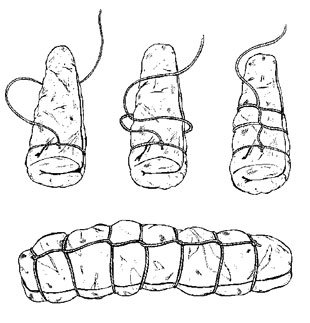 The pork loin roast is generally a sad thing. Often dry and tasteless because of its lack of fat, the lowly loin is generally left to be cut into boneless chops, then pounded, breaded and fried to death. It’s worse in America, where industrial pork production has bred all the taste out of pork. But it doesn’t have to be this way! Brining, crusting and stuffing this dirt-cheap cut of meat, and then cooking carefully, will bring out great flavor.
The pork loin roast is generally a sad thing. Often dry and tasteless because of its lack of fat, the lowly loin is generally left to be cut into boneless chops, then pounded, breaded and fried to death. It’s worse in America, where industrial pork production has bred all the taste out of pork. But it doesn’t have to be this way! Brining, crusting and stuffing this dirt-cheap cut of meat, and then cooking carefully, will bring out great flavor.
This recipe does all three: brine, crust and stuff. Of all these, brining is the most important. You might choose just to crust or stuff. But why not go for the gold?! I stuff the roast with Swiss chard, fennel, raisins and pine nuts, but you are only limited by your creativity when devising a stuffing.
This recipe easily serves 4 with lots left over for sandwiches. The brining process will take about 2 hours before you can begin cooking.
Ingredients and Directions:
- 3-4 lb pork loin roast or pork sirloin roast (sirloin is the end cut of a full pork loin)
- 1 cup kosher salt
- ½ cup sugar
- Black peppercorns
- 6 stems of Swiss chard
- 1 large fennel bulb, sliced
- ¼ cup golden raisins
- 2 tablespoons pine nuts
- 1 tablespoon fennel seeds
- ½ tablespoon anise seeds
- TINY punch of red pepper flakes
- Salt and pepper
Special equipment:
- A large container big enough to hold the pork loin roast in the brining solution
- Kitchen twine
- Sheet pan
- Meat thermometer
- Spice grinder
- In the large brining container, dissolve the kosher salt and sugar in 1 gallon of water. Add about 10 peppercorns to the mixture and submerge the pork loin. Add two big handfuls of ice cubes. Let the pork brine for two hours. If you continue to add ice and keep the brine at 41 degrees F or below, you can leave this in your sink while brining. Otherwise, refrigerate.
- Remove the pork loin and dry completely with paper towels. Discard the brining solution.
- While the pork is brining, prepare the stuffing:
- In boiling salted water, blanch the Swiss chard leaves for 1 minute, then remove to a strainer and rinse under cold water. Layout the leaves flat on a board and cut out the thickest part of the stem so the leaves will easily fold.
- Toast the pine nuts in a dry saute pan for about 2 minutes. Keep a careful eye on them, as they can quickly burn. Stir them around in the pan until they are lightly toasted on all sides. Remove to a bowl (they will burn if you leave them in a hot pan).
- Soak the golden raisins in hot boiling water for about 15 minutes. Drain and squeeze the excess water.
- In a saute pan over medium heat, add a little olive oil and saute the sliced fennel until very soft. About 10 minutes. Add a little salt and pepper at the end and stir.
- Preheat the oven to 400-degrees F.
- Butterfly the pork loin. (You can also ask your butcher to do this when buying the pork. He will gladly do it for free.) To butterfly, follow these easy steps:

- Set the pork on a cutting board fat side down with the end facing you. Using a long, thin, sharp knife, and starting 1 inch above the underside of the roast, cut 1 inch in, along the right side.
- Continue cutting ½ inch above the underside of the roast, unrolling the meat as you cut.
- Continue cutting until the roast is opened flat and is 1 inch thick.
- Lay the pork loin out on a cutting board, opened like a book. Season with salt and pepper. Cover the inside of the roast by laying out the Swiss chard leaves. Then sprinkle with softened fennel, golden raisins and pine nuts. Season with a little more salt and pepper.
 Roll the pork loin up lengthwise like a jellyroll. Have a friend to help you use the kitchen twine to tie the jellyroll pork about every 2 inches. The really snazzy way to do this is shown to the right.
Roll the pork loin up lengthwise like a jellyroll. Have a friend to help you use the kitchen twine to tie the jellyroll pork about every 2 inches. The really snazzy way to do this is shown to the right.- Make a spice rub by grinding the fennel seed, anise seed, a TINY pinch of the red pepper flakes, 1 teaspoon of course Kosher salt and 5 or so peppercorns in a spice grinder. Pour a little olive oil over the prepared roast and rub all over with your hands. Sprinkle the spice rub all over the roast and evenly distribute with your hands. Place the roast on a metal sheet pan.
- Roast in the oven for approximately 60 minutes, rotating the roast every 15 minutes so you get an evenly seared crust all the way around. This is when you really need to rely on a meat thermometer: roast until the internal temperature reaches 135 degrees F.
- Remove from the oven, cover with aluminum foil, and let rest for 10-15 minutes before serving.
- To serve, remove the kitchen string and thinly slice. Serve with a roasted vegetable.
